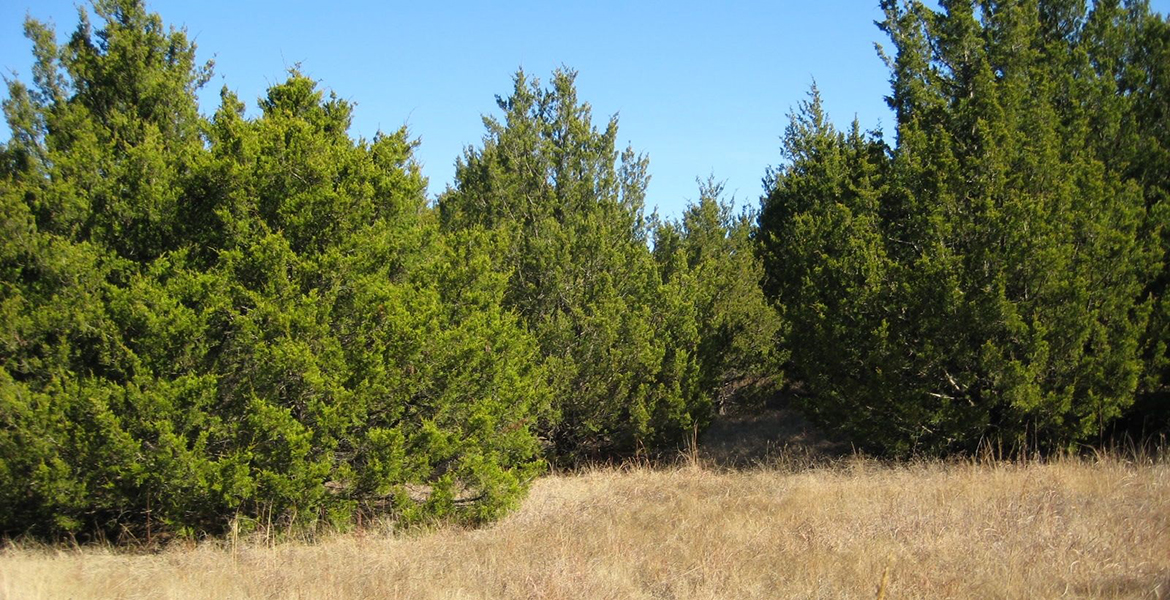
Redcedar expansion impacting natural water cycle
Wednesday, March 27, 2019
Spring brings promises of returning warmth, new life and the annual green-up. With this, the contrast between the brown winter landscape and the evergreen eastern redcedar diminishes. But the threat of redcedars does not.
Many Oklahomans are all too aware of the highly allergenic pollen of the eastern redcedar. Added to that is their high flammability. This can lead to devastating wildfires and increase their ability to quickly invade and convert vital prairies into unproductive stands of redcedar.
Another well-known threat of redcedar expansion is its negative impact on the natural water cycle. Dense redcedar stands can reduce soil moisture and potentially cause a decrease in runoff and groundwater recharge at a local scale due to some unique characteristics. Redcedars consume and evapotranspire more water than most other plants. Their leaves act as a canopy over the soil, catching the rainfall and preventing it from reaching the ground.
As redcedars keep expanding into grassland and oak forests, and monopolize water resources, Oklahomans are at risk of losing a considerable amount of water in the streams, ponds, and reservoirs.
For these reasons, researchers want to find ways to control the expansion of redcedar in Oklahoma. In 2010, researchers at Oklahoma State University began doing just that.
Chris Zou and Rodney Will, professors in the department of Natural Resource Ecology & Management, chose sites with dense stands of redcedar at the Cross Timbers Experimental Range to undergo one of two redcedar removal treatments. In one treatment, redcedars were simply cut and removed with no additional changes. In the other, native switchgrass was planted in the newly cleared area. Switchgrass was chosen because it offers many benefits.
“Switchgrass is great for soil water retention. It is also a dedicated feedstock for produce biofuel, making it a potentially profitable crop,” Will said. “The goal was to cut the cedars, restore water flow, and explore alternative land uses for landowners.”
Yu Zhong is working towards his Ph.D. by studying the soil moisture, runoff, and groundwater recharge within these treated sites. The initial data from Zhong appear to show redcedar removal improves soil water and increases runoff in restored prairie. Areas converted to switchgrass may have even higher water yield.
“Switchgrass is efficient in water use. Biomass removal in the Fall mimics biofuel feedstock harvest, and may allow more runoff to replenish nearby waterbodies,” Zou said.
Though the initial data show promise, conclusions ultimately will be based on results from multiple years to capture different climate conditions.
“At the end of 2019, we will have collected three years of data with fully grown switchgrass. This body of knowledge will help us better understand the ecological benefits of replacing redcedar with switchgrass,” Zou said.
Redcedars, which now cover more than 25 percent of the state, are spreading at an almost exponential rate. Fortunately, there are many simple ways to combat the invasion. One option is cutting trees below the first green branch, but the most inexpensive and effective tool is fire. Fire is especially effective on larger properties, with smaller trees, and on less dense stands.
Managing redcedar expansion is beneficial to your land and Oklahoma’s water future.
For more information, contact your local OSU Cooperative Extension office, the Water
Center, or explore the redcedar resources at http://water.okstate.edu/expertise/environment.
Story by Ali Meek
